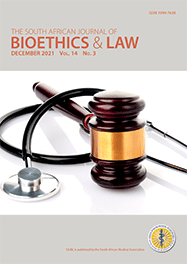Home >
The right to physical integrity and informed refusal: Just how far does a patient’s right to refuse medical treatment go? >
Reader Comments >
DTrim Advanced Support-Will airplane ear go...
User
CONTACT THE EDITOR
Professor Ames Dhai
Popular Articles
Reader Comments
This journal is protected by a Creative Commons Attribution - NonCommercial Works License (CC BY-NC 4.0) | Read our privacy policy. Our Journals: South African Medical Journal | African Journal of Health Professions Education | South African Journal of Bioethics and Law | South African Journal of Child Health | Southern African Journal of Critical Care | Strenghtening Health Systems |



.jpg)
DTrim Advanced Support-Will airplane ear go away on its own?
by fiona basil (2021-07-02)
Airplane rides are generally pleasant experiences, the calm of the flight attendants and the fragrant air-conditioned interiors are enough to send one to a calm state of mind. But then there are some problems that come up with height. While some people vomit due to an altitude phobia, there are other people who end up having a huge difference in ear pressure leading to intolerable earache. But are there ways to avoid earache during an airplane flight?
Why do my ears hurt during a plane flight?
This happens due to the uneven pressures that develop on either side of the eardrum as the plane ascends or descends.
The pain may be worse when the plane is about to land or take off. The pain in the ears usually goes away shortly after landing or when the plane has stabilized. To alleviate this, doctors suggest that the pressure inside the middle ear should decrease rapidly during that climb and increase rapidly during descent from the plane.
It is the ascent and descent of a flight that causes aviators to experience pain pounding their ears for agonizing minutes. A thin opening between the middle ear and the nose is to blame for this uncomfortable sensation.
The Eustachian tube must readjust to accommodate the change in air pressure, and this process is more of a problem for some people than others, especially those with allergies and a sinus problem.
5 tips to avoid earache during takeoffs and landings
To help the tubes open or close more smoothly, there are certain tried and tested techniques one could follow to relieve pain.
To avoid earache, practice the Valsava maneuver
The Valsava maneuver is a simple technique that involves passing through the nose when the nostrils are pinched. One must repeat the process several times to discover relief from earache.
In this way, no air is being blown but one is gently pushing air into the Eustachian tube. If you do this, you may feel your ears "pop" when air is pushed into the middle ear. This often cures the problem. This allows the pressure in the inner ear to equalize with the atmosphere around the person.
Yawning and swallowing frequently
The act of yawning and swallowing also stimulates the muscles that help unblock the Eustachian tube, especially during landings. Some airlines offer their passengers candy before a flight to help solve the same problem. Next time, wait for the flight to take off before putting those treats in your mouth. For babies, it is a good idea to breastfeed or give them a drink at takeoff and descent to encourage swallowing.
Try a decongestant
You should consult a doctor or pharmacist before investing in decongestants such as nasal sprays, drops, or pills. Nasal sprays are generally sprayed after every 15 minutes before flight take off and 15 minutes before landing to help clear the nose. Oral decongestants are generally not recommended for people in the older age group.
Do not sleep when the plane takes off or descends to the ground
People believe that sleeping during takeoffs and landings will help them get through the pain-free phase, but it is best to stay awake and practice the techniques mentioned above to avoid suddenly waking up in mid-flight with severe earache. Take a few minutes to help your ears adjust to the air pressure, and then you can sit back and enjoy the rest of your flight.
You can also ask the aircraft personnel to wake you up when the plane begins to descend. If you are already awake, you should sip and swallow to stimulate air to enter the middle ear to avoid pain. Breathing deeply in the style of breathing before yawning is also effective in this case.
Medications and pills
Take any pain reliever half an hour before takeoff or landing. Paracetamol or ibuprofen are available; Avoid any pain reliever that contains caffeine, as it can lead to dehydration. An over-the-counter nasal decongestant can also help unclog the ear and nasal passages. Instead of chewing gum, the classic cure is to opt for a throat lozenge or suck on hard candy. Chewing gum will dry out your throat, while lozenges can soothe it.
Earache due to fluctuations in air pressure is very common in a healthy body, therefore it is only natural that in a body fighting a cold, nasal, sinus and ear infection, one should ensure that plan ahead for the flight, if not avoid flying altogether until the body recovers.
An ear infection could get worse during flight and ear infection. In some severe cases, it can even lead to a ruptured eardrum and consequent hearing loss. To avoid earache during an airplane flight, it is recommended that frequent travelers who suffer frequent pressure changes in the ears, be evaluated for allergies and disorders.
Most people have lived with extra body weight at one point in their lives, and know how difficult it is to sustain healthy weight loss. Of course, the best way for healthy weight loss is through a well-rounded diet and exercise routine, but using the principles of integrative medicine can help support different hormones, neurotransmitters, and metabolic reactions that work with your individual physiology to help you burn body fat more efficiently. DTrim Advanced Support